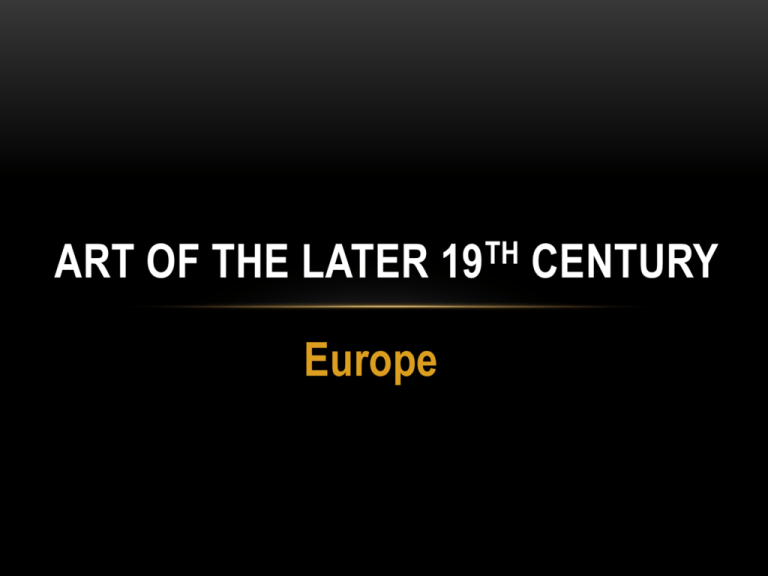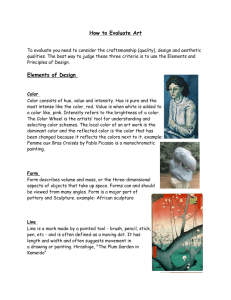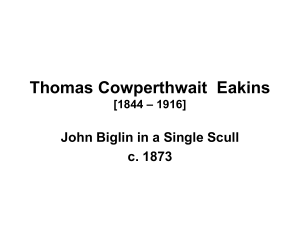Art of the Later 19th Century
advertisement

ART OF THE LATER Europe TH 19 CENTURY PURPOSE OF ART IN EUROPE • Paint contemporary world • Present more personal, expressive view of life • Impressionist regard for light and its effect on color • more intense color POST-IMPRESSIONISM • Post-Impressionism: the French art movement that immediately followed Impressionism • Artists show greater concern for structure and form PAUL CÉZANNE: HIS TECHNIQUE • apply colors in small, flat patches side-by-side so that each represented a separate plane • To make objects look more threedimensional, he used: • cool colors and warm colors • sought weight and solidity in still lifes, landscapes and portraits STILL LIFE WITH PEPPERMINT BOTTLE • flat • blue tones to show depth • Straight lines contrasted with curved lines to add variety CÉZANNE’S LANDSCAPES • Inspired Cubism • Pines and Rocks (Fontainebleau?) • small brush strokes to suggest form of the rock • cubes of color for foliage VINCENT VAN GOGH: HIS TRADE-MARK STYLE • bright colors • twisting lines (distortion) • bold brushstrokes • thick application of paint • Painted what he felt VINCENT VAN GOGH: HIS PAINTING BACKGROUND • Early: painted in browns and other blah colors • showed peasants in daily routines • After meeting Impressionists, added color and used small, short brushstrokes • Influenced the Fauves and the Expressionists The Potato Eaters Bedroom at Arles THE STARRY NIGHT (A REFLECTION OF AN OPTIMISTIC VIEW OF DEATH) PAUL GAUGIN • Spirit of the Dead Watching • exotic subject matter in threedimensional form • flat areas of bright colors combined w/forms that look round & solid • shapes arranged in flat pattern • Influenced groups of primitive artists & American Abstract Expressionists AMERICA IN THE LATE 19TH CENTURY PHILANTHROPY ON THE RISE • Active effort to promote human welfare = Carnegie, Rockefeller, and Morgan funnel riches into schools, colleges, & museums. • Changes in American Art • Self-taught artists roamed from village to village • Other artists studied in the art centers of Europe • some stayed and became part of the European art movement • some returned to U.S. to develop American art styles WINSLOW HOMER • The Fog Warning • Different values separate the sea, the sky, and the fog • Dramatic use of line: contrasting lines • diagonal axis lines of the dory and portions of the windblown fog horizontal contour lines of oars, boat seats, horizon, and fog bank THOMAS EAKINS • Studied with Neoclassicists and influenced by Courbet’s realism • Earlier Masters influenced him: Velazquez, Hals, and Rembrandt • Rembrandt: use of light and dark values to create solid, round, life-like figures • Favorite subject matter: people and themes of Philadelphia • Painted only what he saw. • The Gross Clinic • attention to detail: intense study of anatomy by dissection • portrayal of figures in space ALBERT PINKHAM RYDER • Inspired by: • the Bible, Chaucer, Shakespeare, and 19 th Century Romantic writers • within himself (he was a hermit) • Emphasis on Color and Texture • small pictures built up until forms nearly 3dimensional • paints of poor quality and/or applied improperly = colors have faded J O N A H F L Y I N G D U T C H M A N AFRICAN AMERICAN ARTISTS EDWARD MITCHELL BANISTER • First African American painter to win a major award at an important exhibition. • Preferences for romantic interpretations of nature (land or sea) • also painted portraits and other subjects The Newspaper Boy HENRY TANNER • Most famous African-American artist of late 19th, early 20th centuries • From a family of high achievers • Father = a Bishop in the African Methodist Episcopal Church • Mother = founded one of the 1st black women’s organizations in U.S. • Sister: one of the first women doctors in Alabama • Studied at the Pennsylvania Academy of the Fine Arts with Eakins HENRY TANNER (CONT.) • Eakins convinced Tanner to turn from landscapes to genre scenes • The Banjo Lesson • simplicity • Changed to Biblical subjects and moved to Paris • Daniel in the Lion’s Den EDMONIA LEWIS • Chippewa and African-American from Ohio • Sculptor: Marble carving • Popular until demand for bronze sculpture grew • Forever Free • A celebration th of the 13 Amendment





